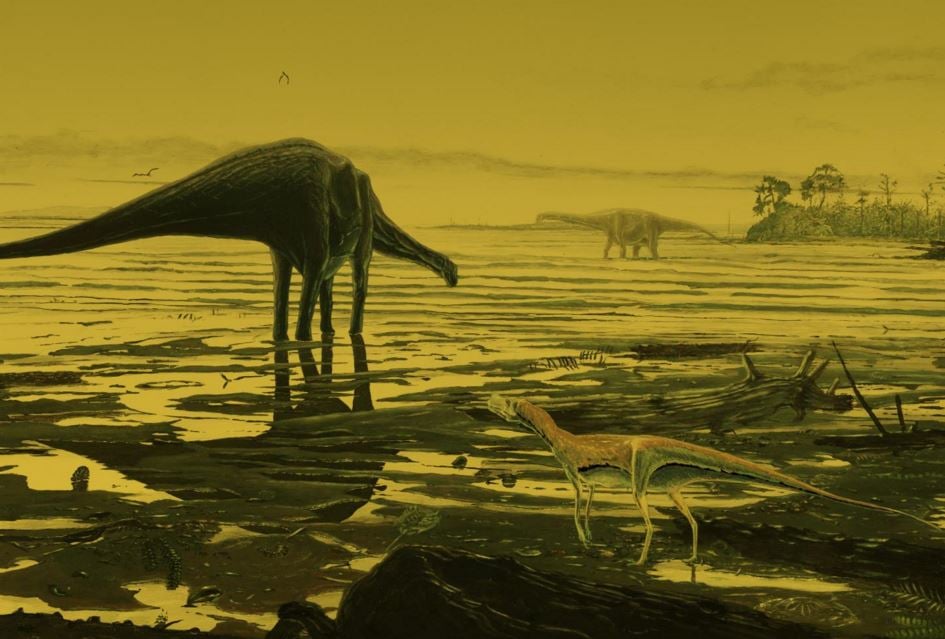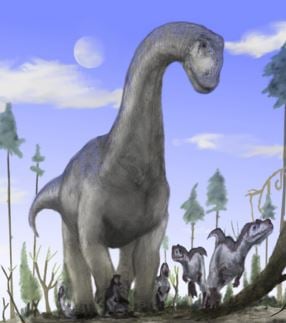Giant dinosaur footprints and handprints have been discovered in the Isle of Skye in Scotland, which researchers from the University of Edinburgh say is proof that plant-eating sauropods – the biggest land animals ever – existed in Scotland about 170 million years ago.
Study leader, Dr. Steve Brusatte, of the University of Edinburgh’s School of GeoSciences, and colleagues wrote about their findings in the Scottish Journal of Geology.
Dr. Brusatte and team said they found hundreds of handprints and footprints made by giant sauropods – herbivorous dinosaurs with long necks and relatively small heads that were up to 120 feet long. The ones that lived in Scotland at the time were probably at least 49 feet (15 metres) long, the authors wrote.
 An artist’s impression of sauropod dinosaurs on the Isle of Skye. They possessed very long tails, which may have been able to crack like a whip and protect them from predators. (Image: eurekalert.org. Credit: John Hoad)
An artist’s impression of sauropod dinosaurs on the Isle of Skye. They possessed very long tails, which may have been able to crack like a whip and protect them from predators. (Image: eurekalert.org. Credit: John Hoad)
Scotland’s largest dinosaur discovery
This is the biggest dinosaur discovery ever found in Scotland, and helps fill an important gap in the evolution of the enormous animals.
The scientists identified the tracks on layers of rock, which when these creatures were alive would have been at the bottom of a shallow, salt-water lagoon.
After analyzing the footprints’ structure, the team members found that the dinosaurs were early, distant relatives of more well-known species, such as Diplodocus and Brontosaurus.
The largest footprint is 70 cm (27.5 in) in diameter. They are the first sauropod tracks to be discovered in Scotland. Before this discovery, the only evidence that sauropods existed in Scotland came from some bone and teeth fragments.
Fossils from the Middle Jurassic Period are extremely uncommon – the Isle of Skye is one of the few places globally where they can be found.
 These tracks were made by sauropod dinosaurs on the Isle of Skye about 170 million years ago. (Image: eurekalert.org. Credit: Steve Brusatte)
These tracks were made by sauropod dinosaurs on the Isle of Skye about 170 million years ago. (Image: eurekalert.org. Credit: Steve Brusatte)
The authors said their discovery has given scientists a better idea of the lifestyles and habitats of the world’s largest dinosaurs.
Sauropods liked areas with shallow water
According to data gained from these tracks and similar ones found in other parts of the world, scientists can now conclude that sauropods spent much of their time in shallow water and coastal areas. It had been thought that these big dinosaurs were pure land-dwellers.
In an Abstract in the journal, the authors wrote:
“The new Skye tracks document multiple generations of sauropods living within the lagoonal environments of Jurassic Scotland, and along with other tracks found over the past two decades, suggest that sauropods may have frequented such environments, contrary to their image as land-bound behemoths.”
The University of Edinburgh team found the trails during fieldwork in collaboration with scientists from Skye’s Staffin Museum.
Dr. Brusatte said:
“The new tracksite from Skye is one of the most remarkable dinosaur discoveries ever made in Scotland. There are so many tracks crossing each other that it looks like a dinosaur disco preserved in stone.”
“By following the tracks you can walk with these dinosaurs as they waded through a lagoon 170 million years ago, when Scotland was so much warmer than today.”
Co-author Dr. Tom Challands, who also works at the School of GeoSciences, said:
“This find clearly establishes the Isle of Skye as an area of major importance for research into the Mid-Jurassic period. It is exhilarating to make such a discovery and being able to study it in detail, but the best thing is this is only the tip of the iceberg.”
“I’m certain Skye will keep yielding great sites and specimens for years to come.”
The study was supported by the Royal Zoological Society of Scotland and the University of Edinburgh.
Citation: “Sauropod dinosaur trackways in a Middle Jurassic lagoon on the Isle of Skye, Scotland,” Stephen L. Brusatte, Thomas J. Challands, Dugald A. Ross and Mark Wilkinson. Scottish Journal of Geology. First published online December 1, 2015. DOI: 10.1144/sjg2015-005.
BBC Video – How did sauropods support their weight?
In this BBC video, science reporter Victoria Gill tells us that sauropods were the largest animals ever to walk the Earth. They grew up to 40m long and could weight over 80t. So, how did they manage to support such a massive weight?

